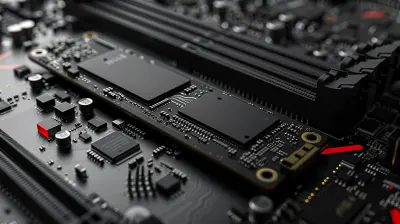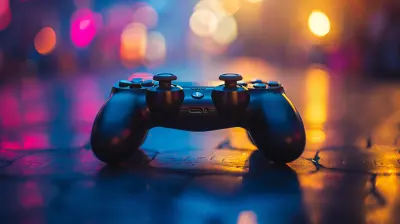24 March 2025
If you’ve spent any time on the competitive gaming scene (or even just casually spectating your favorite esports tournaments), you’ve probably noticed how lightning-fast players’ reactions can be. But have you ever paused to wonder how they pull off those jaw-dropping moves? Whether it’s perfectly timing a headshot in "Counter-Strike" or pulling off a game-saving parry in "Street Fighter," the science of reflexes plays an incredible role in competitive gaming. Let’s dive deep into what’s really going on behind the screen.

What Are Reflexes?
Before we talk about how reflexes impact gaming, let’s cover the basics. Reflexes are your body's automatic responses to certain stimuli. Imagine accidentally touching a hot stove. You’d yank your hand away before your brain even had time to process what’s happening. That’s your reflex arc at work.In gaming, reflexes are about processing visual, auditory, and tactile cues—and responding as quickly as possible. Whether it’s spotting an enemy player peeking around a corner or hearing the infamous footsteps in "Call of Duty," players rely on their reaction times to stay competitive.
Reaction Time vs Reflexes: What's the Difference?
A quick clarification: while we often use “reaction time” and “reflexes” interchangeably, they’re not exactly the same thing. Reflexes are involuntary and don’t require conscious thought, while reaction time involves recognizing a stimulus, making a decision, and then acting on it. In gaming, both play a big role.For example:
- Reflexes help you instinctively dodge a rocket in "Overwatch" without even thinking.
- Reaction time comes into play when deciding whether to take cover or counterattack after spotting an enemy.
Think of it like driving a car. Reflexes kick in if someone suddenly cuts you off, but reaction time is needed when you decide whether to brake or swerve.
The Neuroscience of Reflexes in Gaming
So, what’s happening in your brain when you pull off an insane flick shot? It all starts with your central nervous system (CNS), which includes your brain and spinal cord.The Reflex Arc in Action
When you see an enemy in a video game, your eyes capture that information and send it to your brain's visual cortex. The brain processes the image, identifies it as a threat, and sends instructions to your fingers to click or tap. This entire process happens in milliseconds.Here’s a simplified breakdown:
1. Stimulus: You spot an opponent (visual input).
2. Processing: Your brain assesses the situation.
3. Action: Your hand responds by moving the mouse or pressing a button.
The faster your brain can connect these dots, the better your in-game performance.
Muscle Memory: The Secret Weapon
If you’ve ever watched professional gamers play, you’ve likely noticed that they don’t seem to “think” about their actions—they just do. This is because of muscle memory, which is built through repetition. By practicing the same movements (like aiming, shooting, or dodging) over and over, your brain creates neural pathways that allow these actions to bypass conscious thought.This is why seasoned players seem to have superhuman reflexes. They’ve trained their hands to respond almost automatically, turning a thought into quick action.
Factors That Influence Reflexes in Competitive Gaming
Here’s the thing: not everyone has the same reaction time. Several factors can impact your reflexes and gaming performance. Let’s break them down:1. Age
Sorry, but we have to rip off the Band-Aid—reaction time tends to slow with age. Studies show that reaction times peak in your late teens and early twenties, after which they gradually decline. However, don’t despair! Experience and game sense can often compensate for slower reactions.2. Caffeine & Stimulants
Ever wonder why so many streamers are constantly sipping on energy drinks or coffee? Caffeine is a mild stimulant that can temporarily improve alertness and reaction time. Just don’t overdo it—too much caffeine can cause jitters, which might throw off your aim.3. Sleep & Fatigue
If you’re pulling all-nighters and wondering why your gameplay feels sluggish, this might be your answer. Adequate sleep is crucial for maintaining sharp reflexes. Fatigue doesn’t just slow reaction time—it also affects your ability to focus and make decisions.4. Health & Fitness
Surprise, surprise: physical fitness impacts more than just your waistline. Regular exercise improves blood flow and oxygen delivery to the brain, which can enhance cognitive function and reaction times.
How Reflexes Shape Different Gaming Genres
Not all games demand the same level of reflexes. Here’s how reflexes come into play for various genres:1. First-Person Shooters (FPS)
This is where lightning-fast reflexes really shine. Games like "Valorant" and "Rainbow Six Siege" demand split-second decisions and precise aim. Missing a single shot could mean the difference between victory and defeat.2. Fighting Games
Fighting games, like "Mortal Kombat" and "Tekken," are all about frames—fractions of a second can determine whether you land a combo or get punished. Reflexes are critical for blocking, countering, and executing high-level strategies.3. Real-Time Strategy (RTS)
In RTS games like "StarCraft," reflexes are about quick clicks and fast decision-making. While it’s less about raw reaction speed and more about multitasking, players still need fast fingers to stay competitive.4. MOBA (Multiplayer Online Battle Arena)
In MOBAs like "League of Legends" or "Dota 2," reflexes matter for dodging skill shots, landing abilities, and reacting to enemy ganks. Quick decision-making here can turn team fights in your favor.Can You Train Yourself to Have Better Gaming Reflexes?
Absolutely! Reflexes aren’t set in stone—they can be improved with practice and a bit of science-backed training. Here are some tips:1. Play Regularly
Practice makes perfect—literally. The more you play, the more familiar you become with a game’s mechanics and pace, which sharpens your reflexes over time.2. Warm-Up Before Playing
Professional gamers swear by warm-ups. Spend 10–15 minutes in aim trainers (like "Kovaak’s" or "Aim Lab") before jumping into matches. It’s like stretching before a workout—it primes your muscles and brain for action.3. Train Your Peripheral Vision
Your ability to track movement outside your direct line of sight is crucial. Games like "Osu!" or reaction apps can help enhance your peripheral awareness.4. Maintain a Healthy Lifestyle
As mentioned earlier, good sleep, regular exercise, and a balanced diet go a long way. Think of your body as your gaming rig—optimal health equals optimal performance.5. Use Reaction Training Tools
Apps like "Reflexion" or websites like "Human Benchmark" let you test and train your reaction times. These tools can simulate in-game scenarios and push your reflexes to the limit.The Role of Technology in Reflex-Based Gaming
Beyond natural reflexes, technology can also play a part in boosting your response times. Here are a few factors:1. Monitor Refresh Rates
A higher refresh rate (like 144Hz or 240Hz) means smoother visuals, allowing you to process information more quickly. It’s a game-changer for competitive gaming.2. Low Input Lag Peripherals
Gaming mice, mechanical keyboards, and controllers with low input lag ensure that your actions are registered as quickly as possible.3. Better Internet Connection
Poor ping can make even the fastest reflexes feel sluggish. A stable, low-latency connection is crucial for competitive play.Wrapping It Up
At the heart of competitive gaming, reflexes are what separate the casual players from the pros. Whether you’re snapping to an opponent’s head in "Apex Legends" or dodging a hook in "Dota 2," your reaction time and reflexes can make or break your performance.The good news? While genetics and age play a role, there’s plenty you can do to train and improve. By staying consistent, taking care of your body, and incorporating tools to refine your skills, you’ll be on your way to leveling up your reflexes—and your gameplay.
What about you? Got any killer tips for improving reflexes in gaming? Let us know in the comments!






Caden Wade
Reflexes reveal the mind's intricate dance of focus.
April 1, 2025 at 2:57 AM